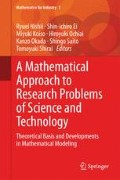Abstract
Cryptography was once considered to be a means of maintaining secrecy of communications only in military affairs and diplomacy. However, today, modern cryptography is used for various purposes in familiar circumstances. Public-key cryptography is a key technology of modern society; it is used for personal authentication, electronic commerce on the Internet, copyright protection of DVDs, and so on. In particular, the RSA public-key cryptosystem, which was proposed more than 30 years ago, has become the de facto standard of cryptographic software since the spread of the Internet in the 1990s. Another technology, called elliptic curve cryptography, was proposed in 1985. It can perform arithmetic processing at high speed, and since the beginning of the 2000s, it has been implemented in devices such as DVD players and personal digital assistants. Pairing-based cryptography, first proposed in 2000, can be incorporated in security technologies that are not practical with the previous public-key cryptographies. It is actively studied by various organizations around the world. In this chapter, we explain the basic mathematics and security evaluations of public-key cryptography.
Access this chapter
Tax calculation will be finalised at checkout
Purchases are for personal use only
References
J.-L. Beuchat, N. Brisebarre, J. Detrey, E. Okamoto, M. Shirase, T. Takagi, Algorithms and arithmetic operators for computing the \(\eta _T\) pairing in characteristic three. IEEE Trans. Comput. 57(11), 1454–1468 (2008)
I. Blake, G. Seroussi, N. Smart, in Elliptic Curves in Cryptography, London Mathematical Society Lecture Note Series, vol 265 (Cambridge University Press, Cambridge, 1999)
I. Blake, G. Seroussi, N. Smart (eds.), in Advances in Elliptic Curve Cryptography, London Mathematical Society Lecture Note Series, vol 317 (Cambridge University Press, Cambridge, 2005)
D. Boneh, M. Franklin, Identity based encryption from the Weil pairing. SIAM J. Comput. 32(3), 586–615 (2003)
D. Boneh, G. Di Crescenzo, R. Ostrovsky, G. Persiano, Public key encryption with keyword search, in Proceedings of EUROCRYPT 2004. LNCS, vol. 3027 (Springer, Heidelberg, 2004), pp. 506–522
D. Boneh, C. Gentry, B. Waters, Collusion resistant broadcast encryption with short ciphertexts and private keys, in Proceedings of CRYPTO 2005. LNCS, vol. 3621 (Springer, 2005), pp. 258–275
D. Boneh, R. Venkatesan, Breaking RSA may not be equivalent to factoring, Proceedings of EUROCRYPT’98. LNCS, vol. 1233 (Springer, 1998), pp. 59–71
X. Boyen, L. Martin, in Identity-Based Cryptography Standard (IBCS) #1: Supersingular Curve Implementations of the BF and BB1 Cryptosystems, RFC 5091 (Informational), December 2007, http://www.ietf.org/rfc/rfc5091.txt
H. Cohen, A. Miyaji, T. Ono, in Efficient Elliptic Curve Exponentiation Using Mixed Coordinates, ASIACRYPT 1998. LNCS, vol. 1514 (Springer, 1998), pp. 51–65
Cryptography Research and Evaluation Committees, http://www.cryptrec.jp/
D. Freeman, M. Scott, E. Teske, A taxonomy of pairing-friendly elliptic curves. J. Cryptol. 23(2), 224–280 (2010)
D. Hanerson, A. Menezes, S. Vanstone, Guide to Elliptic Curve Cryptography (Springer, Berlin, 2003)
T. Hayashi, T. Shimoyama, N. Shinohara, T. Takagi, in Breaking Pairing-Based Cryptosystems Using \({\eta _{T}}\) Pairing Over \(GF(3^{97})\), ASIACRYPT 2012. LNCS, vol. 7658 (Springer, 2012), pp. 43–60
T. Iyama, S. Kiyomoto, K. Fukushima, T. Tanaka, T. Takagi, in IEICE Transaction on Implementation of Pairing Based Cryptosystem on Mobile Phones, vol. J95-A, no. 7 (2012), pp. 579–587 (in Japanese)
T. Izu, T. Takagi, in Efficient Computations of the Tate Pairing for the Large MOV Degrees, ICISC 2002. LNCS, vol. 2513 (2002), pp. 283–297
N. Koblitz, Elliptic curve cryptosystems. Math. Comput. 48, 203–209 (1987)
A.K. Lenstra, H.W. Lenstra Jr., (eds.), in The Development of the Number Field Sieve, Lecture Notes in Mathematics, vol 1554 (Springer, Berlin, 1993)
V. Miller, in Use of Elliptic Curves in Cryptography, CRYPTO 1985. LNCS, vol. 218 (Springer, 1985), pp. 417–426
V. Miller, The Weil pairing, and its efficient calculation. J. Cryptol. 17(4), 235–261 (2004)
J. Pollard, A Monte Carlo method for factorization. BIT Numer. Math. 15(3), 331–334 (1975)
R. Rivest, A. Shamir, L. Adleman, A method for obtaining digital signatures and public-key cryptosystems. Commun. ACM 21(2), 120–126 (1978)
R. Sakai, K. Ohgishi, M. Kasahara, Cryptosystems based on pairing, in The 2000 Symposium on Cryptography and Information, Security, SCIS2000-C20, 2000
O. Schirokauer, Discrete logarithms and local units. Philos. Trans. Royal Soc. A 345(1676), 409–424 (1993)
T. Takagi, T. Okamoto, E. Okamoto, T. Okamoto (Eds.), in Pairing-Based Cryptography—Pairing 2007. LNCS, vol. 4575 (Springer, 2007)
T. Yasuda, T. Takagi, K. Sakurai, in Application of Scalar Multiplication of Edwards Curves to Pairing-Based Cryptography, IWSEC 2012. LNCS, vol. 7631 (Springer, 2012), pp. 19–36
M. Yoshitomi, T. Takagi, S. Kiyomoto, T. Tanaka, in IEICE Transaction on Efficient Implementation of the Pairing on Mobilephones using BREW, vol. E91-D, no.5 (2008), pp. 1330–1337
Author information
Authors and Affiliations
Corresponding author
Editor information
Editors and Affiliations
Rights and permissions
Copyright information
© 2014 Springer Japan
About this chapter
Cite this chapter
Takagi, T. (2014). Introduction to Public-Key Cryptography. In: Nishii, R., et al. A Mathematical Approach to Research Problems of Science and Technology. Mathematics for Industry, vol 5. Springer, Tokyo. https://doi.org/10.1007/978-4-431-55060-0_3
Download citation
DOI: https://doi.org/10.1007/978-4-431-55060-0_3
Published:
Publisher Name: Springer, Tokyo
Print ISBN: 978-4-431-55059-4
Online ISBN: 978-4-431-55060-0
eBook Packages: EngineeringEngineering (R0)

